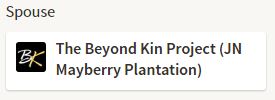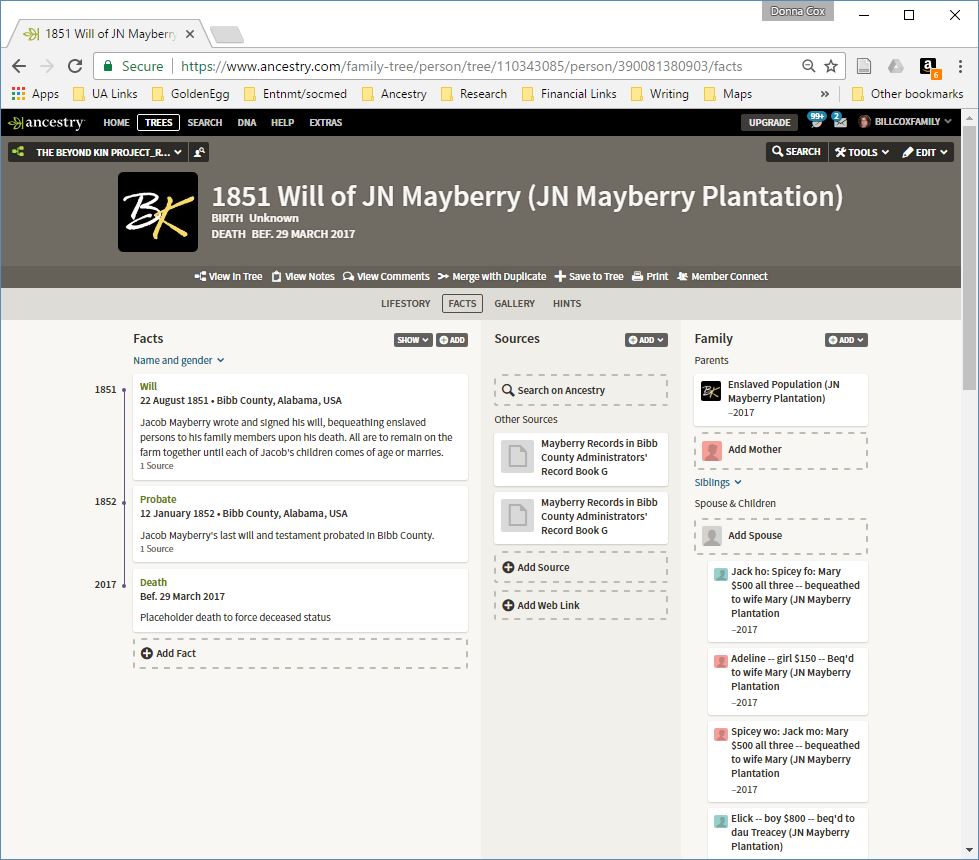 The Beyond Kin method ties people and groups together using the spouse and children connections existing in software solutions like Ancestry.com, Family Tree Maker, Legacy, and RootsMagic. (See The Beyond Kin Project and FamilySearch for a note about incompatibility with this one environment.)
The Beyond Kin method ties people and groups together using the spouse and children connections existing in software solutions like Ancestry.com, Family Tree Maker, Legacy, and RootsMagic. (See The Beyond Kin Project and FamilySearch for a note about incompatibility with this one environment.)
We recommend that any attempts to create Beyond Kin links between slaveholders (SHs) and their enslaved persons (EPs) begin with the SH’s record and work outward, given that most records of use will be associated more directly with the SH’s family.
If you have access to Ancestry.com’s U.S. version, you can explore our prototype tree, starting with Donna Baker’s ancestor, Jacob Newell Mayberry.
The Beyond Kin Framework
This diagram shows the essential framework of creating a Beyond Kin relationship between a SH and the EPs of whom he claimed ownership:

The Beyond Kin Project Spouse
The first spouse attached to the SH will have the given name “The Beyond Kin Project,” with the surname being the institution where the EPs worked. For our examples in this page, the institution will be “(JN Mayberry Plantation).” So the whole name of this first spouse will look something like this:
The Beyond Kin Project (JN Mayberry Plantation)
The Beyond Kin Project spouse serves the function of distancing the SH from the EPs sufficiently to prevent the population from appearing as step-children of the SH. It also creates a flag on a SH’s record that tells anyone doing research that there is another layer of the ancestor’s story.
IMPORTANT NOTE: If you are working in a public tree and want others to be able to find your work, make sure you flag all of the people (virtual and real, free and enslaved) as deceased. If your software perceives them to be alive, they will likely be marked Private to other researchers and blocked from view.
If you are fortunate enough to use genealogy software or online trees that allow you to assign an “Unknown” gender to this spouse and allows you to marry it to others while of this gender, take that option. If your software requires that a female marry a male, you’ll need to make The Beyond Kin Project the opposite gender of your SH.
If your software allows it, also designate the marriage as an “unknown” type. Or, leave the relationship type undesignated, if you’re allowed.
People who happen upon The Beyond Kin Project spouse in other people’s research and are curious about it will likely do an Internet search, which will allow us to introduce them to the method. We also encourage you to use the Beyond Kin Logo as the profile image for this and all other virtual “people” you will create as links to the enslaved personnel.
The Enslaved Population Spouse
The next spousal relationship required to do the Beyond Kin workaround is to marry The Beyond Kin Project spouse to a spouse named Enslaved Population (JN Mayberry Plantation). The Enslaved Population spouse becomes the top-level container of all information being collected about the EPs on your plantation, farm, mine, factory, university, or other institution.
You are going to create virtual “children” from the Enslaved Population person — as a single parent. (Do not make The Beyond Kin Project their other parent or these virtual children will appear as your SH’s step-children in many reports.)
Don't be discouraged if this seems to be getting too complicated. It will get easier every time you do it. And in the end, it will be easier and more efficient than any other method you might devise.
The source “children”
These children you will add to Enslaved Population represent sources of information: documents, books, censuses, etc. This is the unique challenge of slave genealogy — that each source you find might describe the EP differently than the next. It will take research and analysis to figure out which EP in one source matches which one in another.
Let’s say you have found your EPs in an 1850 slave census, for example. You have no names — only gender, approximate age, and occasionally a designation as “mulatto.” If later, you find the SH’s probate inventory, it will probably list the EPs by their first names and their assessed value. It might occasionally group them in family units.
At this stage of your research, you will not be able to tell which person in the slave census matches which one in the probate inventory. And given the lapse of time between the two documents, some of them will have no match at all. You must keep the two lists separate until you can begin to match them based on other sources.
You will keep the lists separate by making each information source a child of Enslaved Population. Let’s call them Source Children. A typical name might be 1850 Slave Census (JN Mayberry Plantation). The use of the same last name on every ancestry record involved allows you to have this group sortable in your indexes.
The EPs will then be added as children of 1850 Slave Census, as a single parent. The given name will be the EP’s name, if available, and any descriptive text that will help to distinguish this individual from others. And they will be given the institution’s last name, as you’ve done for all the spouses.
Creating EP names from censuses
1850 and 1860 Slave Census
For EPs extracted from the slave censuses, we encourage the use of a code that alerts others coming along behind you to which person exactly you were extracting. The name 03a12 mulatto male c1819 (JN Mayberry Plantation), refers to a man who shows up in the 1850 slave census on page (or image) 3, first column, line 12, described as a male of mulatto race, age 31. By using the approximate birth year, rather than the age, you have a better chance of matching this person to those who might appear in other records, also indicating a c1819 birth year.
If you are dealing with more than a few EPs, you will thank yourself later that you identified the line in the census you associated with them. This will prevent you from getting lost in your data entry and will allow you to easily check behind yourself when something appears puzzling. The few extra seconds will be worth it.
Pre-1850 Censuses
For censuses prior to 1850, EPs were accounted for in the same document as the SH family. You will only be given tick marks to identify how many EPs were in each gender/age category. For these, also create unique records for each tick mark. Let’s say you are drawing information from the 1840 census, and there are two identified as Slaves/Male/10 & Under 24. You will create a Source Child to Enslaved Population named something like “1840 Census.” The two EPs will be added as children to 1840 Census with the given names:
Male #1 c1817-1830
Male #2 c1817-1830
In comparing these earlier censuses against each other for changes, you may benefit from a tool like the 90-60 Census Workbook at Genohistory.com.
The growing records
The Enslaved Population ancestry record becomes the gateway to everything you collect about a particular slaveholding institution. By clicking on The Beyond Kin Project — its spouse — you have a path back to the SH. By clicking on any of the Source Children, you can get to a list the EPs from that source.

You will want to copy a traditional source citation to the Source Child and every EP you attach. Eventually you will begin to use your software’s merge feature to combine EPs that you know to be the same person, while appearing in different lists. As you merge these records, you will begin to build a reference list of all the places the EP has been mentioned.
And finally…
Hopefully you now have a sense of how a Beyond Kin group is structured and why. (If not, don’t give up. Doing this is the path to understanding it. Trust us.) Now, let’s look at how you process the records you will mine for slave information.
- Processing the Beyond Kin
Sign up to receive notices of new developments in the project. We will not share your email address outside our team. If you have questions or would like to converse with others who are building Beyond Kin groups, join us at The Beyond Kin Project Forum on Facebook.

